Kurukshetra
Kurukshetra (![]()
Kurukshetra Dharmakshetra | |
|---|---|
City | |
 | |
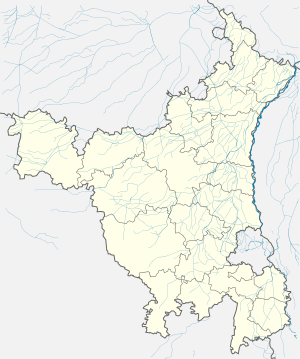 Kurukshetra  Kurukshetra | |
| Coordinates: 29.965717°N 76.837006°E | |
| Country | |
| State | Haryana |
| District | Kurukshetra |
| Named for | Kurukshetra War |
| Area | |
| • Total | 1,530 km2 (590 sq mi) |
| Languages[1][2] | |
| • Official | Hindi |
| • Additional official | English, Punjabi |
| Time zone | UTC+5:30 (IST) |
| PIN | 136118 |
| Telephone code | 911744 |
| ISO 3166 code | IN-HR |
| Vehicle registration | HR-07 |
| Website | kurukshetra |
According to the Puranas, Kurukshetra is a region named after King Kuru, the ancestor of Kauravas and Pandavas, as depicted in epic Mahabharata. The importance of the place is attributed to the fact that the Kurukshetra War of the Mahabharata is said to have taken place here. Thaneswar whose urban area is merged with Kurukshetra is a pilgrimage site with many locations attributed to Mahabharata.[3]
In most ancient Hindu texts, Kurukshetra is not described as a city but a region ("kshetra" means "region" in Sanskrit). The boundaries of Kurukshetra correspond roughly to the central and western parts of the state of Haryana and southern Punjab. According to the Taittiriya Aranyaka 5.1.1., the Kurukshetra region is south of Turghna (Srughna/Sugh in Sirhind, Punjab), north of Khandava (Delhi and Mewat region), east of Maru (desert), and west of Parin.[4]
Legends

According to the Puranas, ancient Hindu texts, the region is named after King Kuru of the Bharata dynasty, who is also the ancestor of Pandavas and Kauravas. These texts also tell that the battle of Mahabharata was fought on this land.
According to the Vamana Purana describes, King Kuru chose land at the banks of the now extinct Sarasvati River (believed to be dried up c. 1900 BCE)[5] for embedding spirituality with eight virtues: austerity (Tapas), truth (Satya), forgiveness (Kshama), kindness (Daya), purity (Shuddha), charity (Daana), devotion (Yajna), and conduct (Brahmacharya). Lord Vishnu was impressed with the acts of King Kuru and blessed him with two boons—first, that this land forever will be known as a Holy Land after his name as Kurukshetra (the land of Kuru); second that anyone dying on this land will go to heaven.
The land of Kurukshetra was situated between two rivers—the Sarasvati and the Drishadvati.
History
Kurukshetra reached the zenith of its progress during the reign of King Harsha, during which Chinese scholar Xuanzang visited Thanesar.
Kurukshetra was conquered by the Mauryan empire in the late 4th century BCE and subsequently became a center of Buddhism and Hinduism. The history of Kurkushetra is little-known in between the collapse of the Mauryans and the rise of the Kushans who conquered the region. After the decline of Kushan power in the region, Kurkushetra became independent only to become conquered by the Gupta empire in the early 4th century CE. Under Gupta rule, Kurukshetra experienced a cultural and religious revival and became a center for Hinduism. After the fall of the Gupta, the Pushyabhuti dynasty ruled over Kurukshetra.[6]
Civil war broke out when Harsha (of the Pushyabhuti dynasty) died without a successor in 647. A Kashmiri army briefly conquered Kurukshetra in 733 but were unable to establish dominion in the area. In 736, the Tomara dynasty was founded and they took over the region. Around the early 9th century, Kurukshetra lost its independence to Bengal. Mahmud of Ghazni sacked Kurukshetra in 1014 and Muslim raiders sacked it in 1034. Kurukshetra was incorporated into the Delhi Sultanate in 1206. Other than a short moment of independence from the result of a rebellion within the Sultanate in 1240, Kurukshetra was under the control of Delhi until 1388.[6]
Kurukshetra became independent once again after the steep decline of the Delhi Sultanate and the raids of Tamerlane near the region. The Sayyid dynasty incorporated Kurukshetra into their territory though the city likely enjoyed some autonomy. The area was much more firmly controlled under the subsequent Lodi dynasty. Some damages to Kurukshetra and its structures occurred during this period. Kurukshetra became part of the Mughal Empire after Babur quashed a local rebellion in 1526. Under Akbar, Kurukshetra once again became a spiritual center not only for Hindus but also for Sikhs and Muslims.[6]
Between the late 17th and early 18th centuries, Kurukshetra was controlled by the forces of the Maratha Empire until the British took over Delhi in 1803. In 1805, the British took Kurukshetra after defeating the Maratha forces in the Second Anglo-Maratha War, who were controlling the city. Since 1947, Kurukshetra has become a popular spiritual center and has seen much infrastructure, development, and restoration of old structures.[6]
International Gita Mahotsav
Gita Jayanti has been celebrated in Kurukshetra for decades. For a long time, it was known as Kurukshetra Utsav. According to the Hindu calendar, the holiday comes on Mokshda Ekadashi in the month of Margshirsh.
In 2016, the government of Haryana decided to give the Gita Jayanti a global flavour and organised an International Gita Mahotsav at Kurukshetra from 1 to 11 December. The Gita Jayanti was celebrated on 10 December as dictated by the traditional calendar. Over 2 million people visited the event that year. Later, in 2017, Gita Jayanti was celebrated on 30 November as per the traditional calendar, and over 2.5 million people visited. The idea of celebrating International Gita Mahotsav came from Swami Gyananand (Founder of GIEO Gita). International Gita Mahotsav 2019 was organized from 23 November 2019 to 10 December 2019. The Haryana government spent over ₹8.94 crore for organising the event.[7]
Vegetarian status
In 2017, the government declared Kurukshetra a holy city and the sale, possession, and consumption of meat are banned within the limits of the Municipal Corporation due to its religious significance.[8]
Geography
Climate
The climate of the district varies as the temperature in summer reaches as high as 47 °C, and as low 1 °C in winter, with rains in July and August.
48 Kos Parikrama of Kurukshetra
Kurukshetra is an important Hindu pilgrimage destination, and there are several pilgrimage sites surrounding the city. The Hindi phrase 48 kos parikrama refers to a roughly 90-km traditional circle (Parikrama) around the holy city (1 kos equals about 3.00 km or 1.91 miles), and a complete parikrama refers to a pilgrimage to all these sites on foot.[9][10]
Places of interest
Hindu religious sites
- Brahma Sarovar: Every year lakhs (hundreds of thousands) of people come to take a holy bath at Brahma Sarovar on the occasion of "Somavati Amavasya" (Sacred No-Moon Day that happens on a Monday) and on solar eclipses. They believe that a bath in the holy Sarovar frees all sins and cycle of birth-death. The Sarovar is one of Asia's largest man-made ponds.[11] Hindu genealogy registers are kept here.
- Sannihit Sarovar: The pond is believed to be the meeting point of seven sacred Saraswatis. The Sarovar, according to popular belief, contains sacred water. Bathing in the waters of the tank on the day of Amavasya (night of complete darkness) or on the day of an eclipse bestows blessings equivalent to performing the Ashvamedh Yajna.
- Jyotisar: The famous site where Bhagavad Gita was delivered to Arjuna under the tree. The tree of that time is witness to Gita.
- Kurukshetra Panorama and Science Centre: A mural depiction of the Mahabharata war.
- Dharohar Museum: A museum about the tradition and cultural depiction of Haryana located in Kurukshetra University.
- Sthaneshwar Mahadev
Other religious or historical sites
- Sheikh Chilli's Tomb: This monument is maintained by the Archaeological Survey of India. It was built during the Mughal era in remembrance of Sufi Saint Sheikh Chehli, believed to be the spiritual teacher of Mughal Prince Dara Shikoh. The Prince's main 'Murshid' or 'Sheikh' (Spiritual Guide), however, is historically known to have been Hazrat Sheikh Mian Mir Sahib, of Lahore,[12] although Sheikh Chehli might have been an additional teacher. Another theory is that the site of the so-called maqbara or tomb
General tourist sites
Educational institutes
- Kurukshetra University
- National Institute of Design, Kurukshetra
- National Institute of Technology, Kurukshetra
- Shri Krishna AYUSH University
District administration
- The Deputy Commissioner, an officer belonging to the Indian Administrative Service, is in charge of the General Administration in the district. He is assisted by a number of officers belonging to Haryana Civil Service and other Haryana state services.
- The Superintendent of Police, an officer belonging to the Indian Police Service, is responsible for maintaining Law & Order and related issues in the district. He is assisted by the officers of the Haryana Police Service and other Haryana Police officials.
- The Deputy Conservator of Forests, an officer belonging to the Indian Forest Service, is responsible for the management of the Forests, Environment, and Wildlife in the district. He is assisted by the officers of the Haryana Forest Service and other Haryana Forest officials and Haryana Wildlife officials.
- Sectoral development is looked after by the district head/officer of each development department such as PWD, Health, Education, Agriculture, Animal Husbandry, Statistics, etc. These officers are from various Haryana state services.
- Shahbad, Ladwa, Pehowa, Babain, Ismailabad, and Jhansa are other towns in the district with significant populations.
In popular art
Ramdhari Singh 'Dinkar' wrote an epic poem titled Kurukshetra, a narrative poem based on the Santi Parva of the Mahabharata. He wrote the poem when memories of the Second World War were fresh in his mind.[13]
Notable persons
Gallery
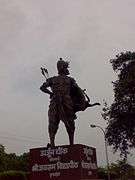 The statue of Arjun at the Arjun Chowk.
The statue of Arjun at the Arjun Chowk.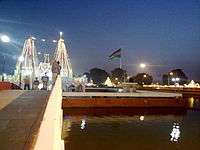 Brahma Sarovar
Brahma Sarovar- Bhishma Kund
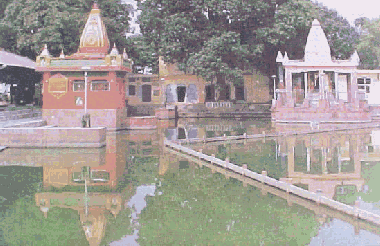 Sannahit Sarovar
Sannahit Sarovar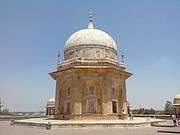 Sheikh Chilli Tomb
Sheikh Chilli Tomb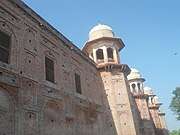 Sheikh Chilli Maqbara.
Sheikh Chilli Maqbara.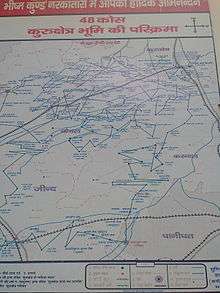 Map depicting all the 48 kos parikrama sites displayed at Ban Ganga/Bhishma Kund
Map depicting all the 48 kos parikrama sites displayed at Ban Ganga/Bhishma Kund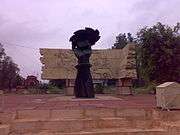 Sudarshan Chakra Chowk near NIT
Sudarshan Chakra Chowk near NIT Bronze Chariot with Lord Krishna and Arjuna in Kurukshetra.
Bronze Chariot with Lord Krishna and Arjuna in Kurukshetra.
References
- "Report of the Commissioner for linguistic minorities: 52nd report (July 2014 to June 2015)" (PDF). National Commission of Linguistic Minorities, India. Commissioner for Linguistic Minorities, Ministry of Minority Affairs, Government of India. pp. 85–86. Archived from the original (PDF) on 15 November 2016. Retrieved 24 March 2019.
- IANS (28 January 2010). "Haryana grants second language status to Punjabi". Hindustan Times. Retrieved 24 March 2019.
- "Kurukshetra (India)". Encyclopædia Britannica. Retrieved 9 August 2014.
- Agarwal, Vishal: Is There Vedic Evidence for the Indo-Aryan Immigration to India? Archived 28 May 2008 at the Wayback Machine
- The Lost River, by Michel Danino. Penguin India 2010
- Schellinger, Paul; Salkin, Robert, eds. (1996). International Dictionary of Historic Places, Volume 5: Asia and Oceania. Chicago: Fitzroy Dearborn Publishers. pp. 507–508. ISBN 1-884964-04-4.
- "Rs 8.94 cr spent on Gita Mahotsav". Tribuneindia News Service. 28 February 2020. Retrieved 4 March 2020.
- "Haryana bans meat in holy towns of Kurukshetra, Pehowa". The Indian Express. Retrieved 31 March 2013.
- "Archived copy". Archived from the original on 25 June 2016. Retrieved 30 May 2016.CS1 maint: archived copy as title (link)
- Service, Tribune News. "K'shetra village renamed after Mahabharata's Abhimanyu". Tribuneindia News Service. Retrieved 29 December 2019.
- Aggarwal, Chandni. "Brahma Sarovar". Times of India Travel. Retrieved 3 September 2019.
- Lahore Gazetteer, 1887, p. 203
- Das, Sisir Kumar (1995). A History of Indian literature. Sahitya Akademi. p. 908. ISBN 978-81-7201-798-9.
External links
| Wikimedia Commons has media related to Kurukshetra. |
| Wikivoyage has a travel guide for Kurukshetra. |